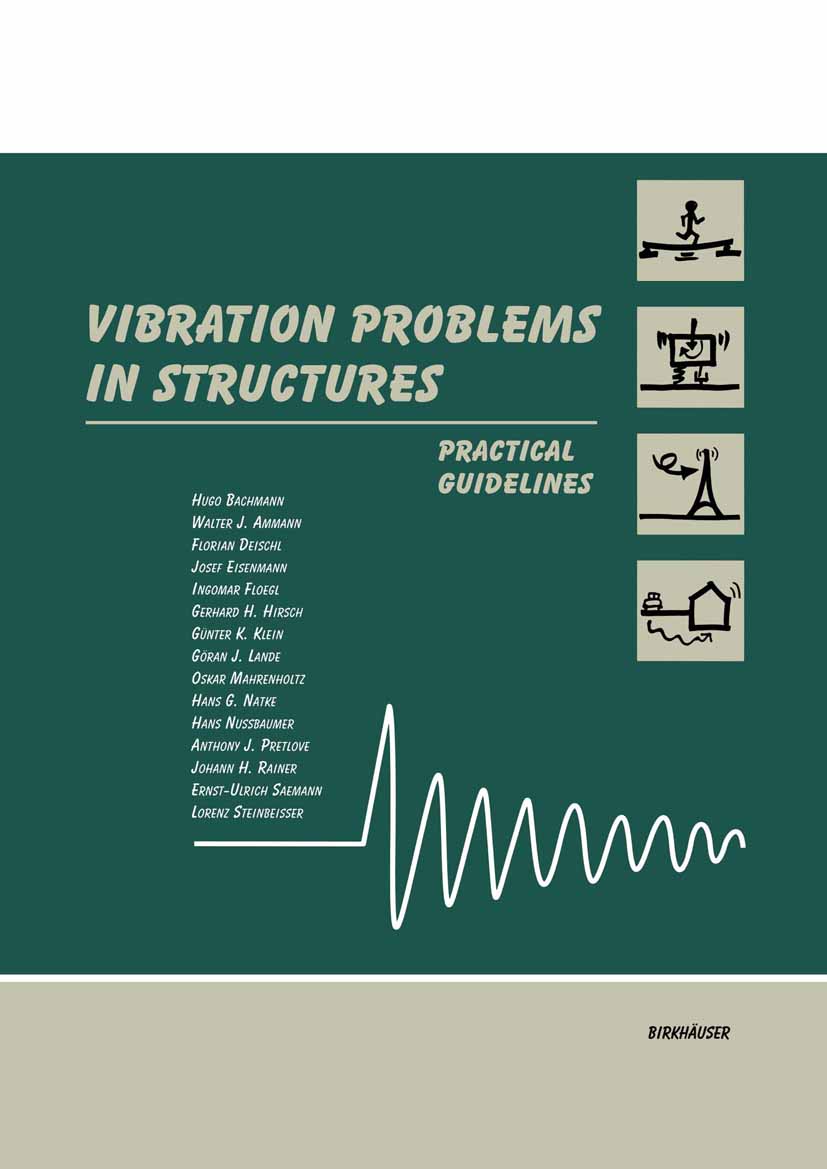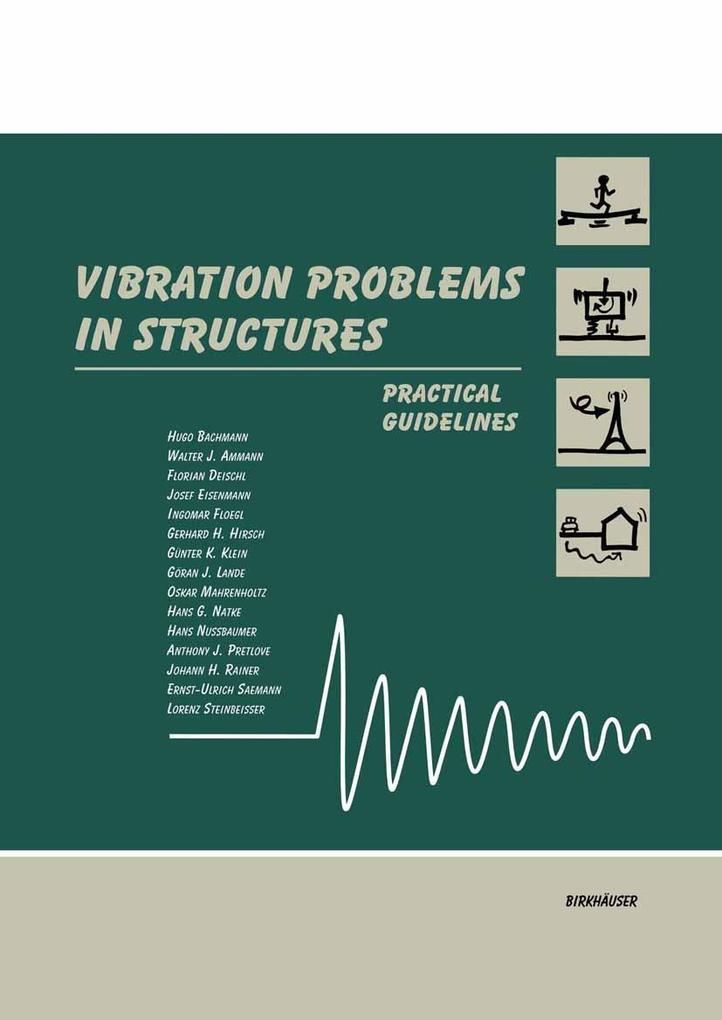
Vibration Problems in Structures - neues Buch
ISBN: 9783034892315
1 Vibrations induced by people.- 1.1 Pedestrian bridges.- 1.1.1 Problem description.- 1.1.2 Dynamic actions.- 1.1.3 Structural criteria.- a) Natural frequencies.- b) Damping.- c) Stiffnes… Mehr…
| ebooks.com new in stock. Versandkosten:zzgl. Versandkosten. Details... |

Vibration Problems in Structures - neues Buch
ISBN: 9783034892315
Vibration Problems in Structures ab 85.49 € als pdf eBook: Practical Guidelines. Aus dem Bereich: eBooks, Sachthemen & Ratgeber, Technik, Medien > Bücher, Vibration Problems in Structures… Mehr…
| Hugendubel.de Nr. 33549060. Versandkosten:, , DE. (EUR 0.00) Details... |

Vibration Problems in Structures - neues Buch
ISBN: 9783034892315
*Vibration Problems in Structures* - Practical Guidelines / pdf eBook für 85.49 € / Aus dem Bereich: eBooks, Sachthemen & Ratgeber, Technik Medien > Bücher nein eBook als pdf eBooks > Sac… Mehr…
| Hugendubel.de Versandkosten:In stock (Download), , Versandkostenfrei nach Hause oder Express-Lieferung in Ihre Buchhandlung., DE. (EUR 0.00) Details... |

Vibration Problems in Structures - neues Buch
ISBN: 9783034892315
Vibration Problems in Structures ab 85.49 € als pdf eBook: Practical Guidelines. Aus dem Bereich: eBooks, Sachthemen & Ratgeber, Technik, Medien > Bücher nein eBook als pdf, Birkhäuser Basel
| Hugendubel.de Versandkosten:In stock (Download), , Versandkostenfrei nach Hause oder Express-Lieferung in Ihre Buchhandlung., DE. (EUR 0.00) Details... |

Vibration Problems in Structures - neues Buch
ISBN: 9783034892315
Vibration Problems in Structures - Practical Guidelines: ab 85.49 € eBooks > Sachthemen & Ratgeber > Technik Birkhäuser Basel eBook als pdf, Birkhäuser Basel
| eBook.de Versandkosten:in stock, , , DE. (EUR 0.00) Details... |


Vibration Problems in Structures - neues Buch
ISBN: 9783034892315
1 Vibrations induced by people.- 1.1 Pedestrian bridges.- 1.1.1 Problem description.- 1.1.2 Dynamic actions.- 1.1.3 Structural criteria.- a) Natural frequencies.- b) Damping.- c) Stiffnes… Mehr…

Walter J. Ammann/ Hugo Bachmann/ Florian Deischl/ Josef Eisenmann/ Ingomar Floegl:
Vibration Problems in Structures - neues BuchISBN: 9783034892315
Vibration Problems in Structures ab 85.49 € als pdf eBook: Practical Guidelines. Aus dem Bereich: eBooks, Sachthemen & Ratgeber, Technik, Medien > Bücher, Vibration Problems in Structures… Mehr…

Vibration Problems in Structures - neues Buch
ISBN: 9783034892315
*Vibration Problems in Structures* - Practical Guidelines / pdf eBook für 85.49 € / Aus dem Bereich: eBooks, Sachthemen & Ratgeber, Technik Medien > Bücher nein eBook als pdf eBooks > Sac… Mehr…

Vibration Problems in Structures - neues Buch
ISBN: 9783034892315
Vibration Problems in Structures ab 85.49 € als pdf eBook: Practical Guidelines. Aus dem Bereich: eBooks, Sachthemen & Ratgeber, Technik, Medien > Bücher nein eBook als pdf, Birkhäuser Basel

Vibration Problems in Structures - neues Buch
ISBN: 9783034892315
Vibration Problems in Structures - Practical Guidelines: ab 85.49 € eBooks > Sachthemen & Ratgeber > Technik Birkhäuser Basel eBook als pdf, Birkhäuser Basel
Bibliographische Daten des bestpassenden Buches
| Autor: | |
| Titel: | |
| ISBN-Nummer: |
Detailangaben zum Buch - Vibration Problems in Structures
EAN (ISBN-13): 9783034892315
Erscheinungsjahr: 2012
Herausgeber: Birkhäuser Basel
Buch in der Datenbank seit 2017-01-02T15:31:05+01:00 (Vienna)
Detailseite zuletzt geändert am 2024-01-24T22:14:34+01:00 (Vienna)
ISBN/EAN: 9783034892315
ISBN - alternative Schreibweisen:
978-3-0348-9231-5
Alternative Schreibweisen und verwandte Suchbegriffe:
Autor des Buches: josef eisenmann, gerhard hirsch, gerhard klein, ingomar, van eyk, hans nussbaum, stein günter, hans lorenz, johann gerhard, ulrich bach, gerhard eisen, ernst günter, hug ernst, ammann, ingo nussbaumer, bachmann hugo walter amman, natke, josef florian, mahrenholtz hans
Titel des Buches: vibration problems
Daten vom Verlag:
Autor/in: Hugo Bachmann; Walter J. Ammann; Florian Deischl; Josef Eisenmann; Ingomar Floegl; Gerhard H. Hirsch; Günter K. Klein; Göran J. Lande; Oskar Mahrenholtz; Hans G. Natke; Hans Nussbaumer; Anthony J. Pretlove; Johann H. Rainer; Ernst-Ulrich Saemann; Lorenz Steinbeisser
Titel: Vibration Problems in Structures - Practical Guidelines
Verlag: Birkhäuser; Springer Basel
237 Seiten
Erscheinungsjahr: 2012-12-06
Basel; CH
Sprache: Englisch
85,59 € (DE)
88,00 € (AT)
94,50 CHF (CH)
Available
XVII, 237 p.
EA; E107; eBook; Nonbooks, PBS / Technik/Maschinenbau, Fertigungstechnik; Maschinenbau: Festkörpermechanik; Verstehen; DIN; Fundament; Mann; Natur; Norm; Pylon; Service; Tower; Vibration; concrete; environment; production; quality; reinforced concrete; structure; C; Vibration, Dynamical Systems, Control; Engineering, general; Building Construction and Design; Multibody Systems and Mechanical Vibrations; Technology and Engineering; Building Construction and Design; Engineering; Ingenieurswesen, Maschinenbau allgemein; Hochbau und Baustoffe; BB
1 Vibrations induced by people.- 1.1 Pedestrian bridges.- 1.1.1 Problem description.- 1.1.2 Dynamic actions.- 1.1.3 Structural criteria.- a) Natural frequencies.- b) Damping.- c) Stiffness.- 1.1.4 Effects.- 1.1.5 Tolerable values.- 1.1.6 Simple design rules.- a) Tuning method.- b) Code method.- c) Calculation of upper bound response for one pedestrian.- d) Effects of several pedestrians.- 1.1.7 More advanced design rules.- 1.1.8 Remedial measures.- a) Stiffening.- b) Increased damping.- c) Vibration absorbers.- 1.2 Floors with walking people.- 1.2.1 Problem description.- 1.2.2 Dynamic actions.- 1.2.3 Structural criteria.- a) Natural frequencies.- b) Damping.- 1.2.4 Effects.- 1.2.5 Tolerable values.- 1.2.6 Simple design rules.- a) High tuning method.- b) Heel impact method.- 1.2.7 More advanced design rules.- 1.2.8 Remedial measures.- a) Shift of the natural frequency.- b) Non-structural elements.- 1.3 Floors for sport or dance activities.- 1.3.1 Problem description.- 1.3.2 Dynamic actions.- 1.3.3 Structural criteria.- a) Natural frequencies.- b) Damping.- 1.3.4 Effects.- 1.3.5 Tolerable values.- 1.3.6 Simple design rules.- 1.3.7 More advanced design rules.- 1.3.8 Remedial measures.- a) Raising the natural frequency by means of added stiffness.- b) Increasing structural damping.- c) Use of vibration absorbers.- 1.4 Floors with fixed seating and spectator galleries.- 1.4.1 Problem description.- 1.4.2 Dynamic actions.- 1.4.3 Structural criteria.- a) Natural frequencies.- b) Damping.- 1.4.4 Effects.- 1.4.5 Tolerable values.- 1.4.6 Simple design rules.- 1.4.7 More advanced design rules.- 1.4.8 Remedial measures.- 1.5 High-diving platforms.- 1.5.1 Problem description.- 1.5.2 Dynamic actions.- 1.5.3 Structural criteria.- a) Natural frequencies.- b) Damping.- 1.5.4 Effects.- 1.5.5 Tolerable values.- 1.5.6 Simple design rules.- a) Stiffness criteria.- b) Frequency criteria.- 1.5.7 More advanced design rules.- 1.5.8 Remedial measures.- References to Chapter 1.- 2 Machinery-induced vibrations.- 2.1 Machine foundations and supports.- 2.1.1 Problem description.- 2.1.2 Dynamic actions.- a) Causes.- b) Periodic excitation.- c) Transient excitation.- d) Stochastic excitation.- 2.1.3 Structural criteria.- a) Natural frequencies.- b) Damping.- 2.1.4 Effects.- a) Effects on structures.- b) Effects on people.- c) Effects on machinery and installations.- d) Effects due to structure-borne sound.- 2.1.5 Tolerable values.- a) General Aspects.- b) Structural criteria.- c) Physiological criteria.- d) Production-quality criteria.- e) Tolerable values relative to structure-borne sound.- 2.1.6 Simple design rules.- a) General.- b) Data desirable for the design of machine supports.- c) Measures for rotating or oscillating machines.- d) Measures for machines with impacting parts.- e) Rules for detailing and construction.- 2.1.7 More advanced design rules.- 2.1.8 Remedial measures.- 2.2 Bell towers.- 2.2.1 Problem description.- 2.2.2 Dynamic actions.- 2.2.3 Structural criteria.- a) Natural frequencies.- b) Damping.- 2.2.4 Effects.- 2.2.5 Tolerable values.- 2.2.6 Simple design rules.- 2.2.7 More advanced design rules.- 2.2.8 Remedial measures.- 2.3 Structure-borne sound.- 2.3.1 Problem description.- 2.3.2 Dynamic actions.- 2.3.3 Structural criteria.- 2.3.4 Effects.- 2.3.5 Tolerable values.- 2.3.6 Simple design rules.- a) Influencing the initiation.- b) Influencing the transmission.- 2.3.7 More advanced design rules.- 2.3.8 Remedial measures.- 2.4 Ground-transmitted vibrations.- 2.4.1 Problem description.- 2.4.2 Dynamic actions.- 2.4.3 Structural criteria.- a) Natural frequencies.- b) Damping.- 2.4.4 Effects.- 2.4.5 Tolerable values.- 2.4.6 Simple design rules.- a) Emission.- b) Transmission.- c) Immission.- 2.4.7 More advanced design rules.- 2.4.8 Remedial measures.- References to Chapter 2.- 3 Wind-induced vibrations.- 3.1 Buildings.- 3.1.1 Problem description.- 3.1.2 Dynamic actions.- 3.1.3 Structural criteria.- a) Natural frequencies.- b) Damping.- c) Stiffness.- 3.1.4 Effects.- 3.1.5 Tolerable values.- 3.1.6 Simple design rules.- 3.1.7 More advanced design rules.- 3.1.8 Remedial measures.- a) Installation of damping elements.- b) Vibration absorbers.- 3.2 Towers.- 3.2.1 Problem description.- 3.2.2 Dynamic actions.- 3.2.3 Structural criteria.- a) Natural frequencies.- b) Damping.- c) Stiffness.- 3.2.4 Effects.- 3.2.5 Tolerable values.- 3.2.6 Simple design rules.- 3.2.7 More advanced design rules.- 3.2.8 Remedial measures.- 3.3 Chimneys and Masts.- 3.3.1 Problem description.- 3.3.2 Dynamic actions.- 3.3.3 Structural criteria.- a) Natural frequencies.- b) Damping.- 3.3.4 Effects.- 3.3.5 Tolerable values.- 3.3.6 Simple design rules.- 3.3.7 More advanced design rules.- 3.3.8 Remedial measures.- 3.4 Guyed Masts.- 3.4.1 Problem description.- 3.4.2 Dynamic actions.- 3.4.3 Structural criteria.- a) Natural frequencies.- b) Damping.- 3.4.4 Effects.- 3.4.5 Tolerable values.- 3.4.6 Simple design rules.- 3.4.7 More advanced design rules.- 3.4.8 Remedial measures.- 3.5 Pylons.- 3.5.1 Problem description.- 3.5.2 Dynamic actions.- 3.5.3 Structural criteria.- a) Natural frequencies.- b) Damping.- 3.5.4 Effects.- 3.5.5 Tolerable values.- 3.5.6 Simple design rules.- 3.5.7 More advanced design rules.- 3.5.8 Remedial measures.- 3.6 Suspension and Cable-Stayed Bridges.- 3.6.1 Problem description.- 3.6.2 Dynamic actions.- 3.6.3 Structural criteria.- a) Natural frequencies.- b) Damping.- 3.6.4 Effects.- 3.6.5 Tolerable values.- 3.6.6 Simple design rules.- 3.6.7 More advanced design rules.- 3.6.8 Remedial measures.- 3.7 Cantilevered Roofs.- 3.7.1 Problem description.- 3.7.2 Dynamic actions.- 3.7.3 Structural criteria.- a) Natural frequencies.- b) Damping.- 3.7.4 Effects.- 3.7.5 Tolerable values.- 3.7.6 Simple design rules.- 3.7.7 More advanced design rules.- 3.7.8 Remedial measures.- References to Chapter 3.- 4 Vibrations induced by traffic and construction activity.- 4.1 Roads.- 4.1.1 Problem description.- 4.1.2 Dynamic actions.- 4.1.3 Structural criteria.- 4.1.4 Effects.- 4.1.5 Tolerable values.- 4.1.6 Simple design rules.- 4.1.7 More advanced design rules.- 4.1.8 Remedial measures.- 4.2 Railways.- 4.2.1 Problem description.- 4.2.2 Dynamic actions.- 4.2.3 Structural criteria.- 4.2.4 Effects.- 4.2.5 Tolerable values.- 4.2.6 Simple design rules.- a) General aspects.- b) Measures against increased vibration level.- 4.2.7 More advanced design rules.- 4.2.8 Remedial measures.- 4.3 Bridges.- 4.3.1 Problem description.- 4.3.2 Dynamic actions.- 4.3.3 Structural criteria.- 4.3.4 Effects.- 4.3.5 Tolerable values.- 4.3.6 Simple design rules.- 4.3.7 More advanced design rules.- 4.3.8 Remedial measures.- 4.4 Construction Work.- 4.4.1 Problem description.- 4.4.2 Dynamic actions.- 4.4.3 Structural criteria.- 4.4.4 Effects.- 4.4.5 Tolerable values.- 4.4.6 Simple rules.- a) Vehicles on construction sites.- b) Piling, sheet piling.- c) Vibratory compaction.- d) Dynamic consolidation.- e) Excavation.- f) Blasting.- 4.4.7 More advanced measures.- 4.4.8 Remedial measures.- References to Chapter 4.- A Basic vibration theory and its application to beams and plates.- A.1 Free vibration.- A.2 Forced vibration.- A.3 Harmonic excitation.- A.4 Periodic excitation.- A.4.1 Fourier analysis of the forcing function.- A.4.2 How the Fourier decomposition works.- A.4.3 The Fourier Transform.- A.5 Tuning of a structure.- A.6 Impedance.- A.7 Vibration Isolation (Transmissibility).- A.8 Continuous systems and their equivalent SDOF systems.- B Decibel Scales.- B.1 Sound pressure level.- B.2 Weighting of the sound pressure level.- C Damping.- C.1 Introduction.- C.2 Damping Quantities (Definitions, Interpretations).- C.3 Measurement of damping properties of structures.- C.3.1 Decay curve method.- C.3.2 Bandwidth method.- C.3.3 Conclusions.- C.4 Damping mechanisms in reinforced concrete.- C.5 Overall damping of a structure.- C.5.1 Damping of the bare structure.- C.5.2 Damping by non-structural elements.- C.5.3 Damping by energy radiation to the soil.- C.5.4 Overall damping.- D Tuned vibration absorbers.- D.1 Definition.- D.2 Modelling and differential equations of motion.- D.3 Optimum tuning and optimum damping of the absorber.- D.4 Practical hints.- E Wave Propagation.- E.1 Introduction.- E.2 Wave types and propagation velocities.- E.3 Attenuation laws.- F Behaviour of concrete and steel under dynamic actions.- F.1 Introduction.- F.2 Behaviour of concrete.- F.2.1 Modulus of elasticity.- F.2.2 Compressive strength.- F.2.3 Ultimate strain in compression.- F.2.4 Tensile strength.- F.2.5 Ultimate strain in tension.- F.2.6 Bond between reinforcing steel and concrete.- F.3 Behaviour of reinforcing steel.- F.3.1 Modulus of Elasticity.- F.3.2 Strength in Tension.- F.3.3 Strain in tension.- G Dynamic forces from rhythmical human body motions.- G.1 Rhythmical human body motions.- G.2 Representative types of activity.- G.3 Normalised dynamic forces.- H Dynamic effects from wind.- H.1 Basic theory.- H.l.1 Wind speed and pressure.- H.l.2 Statistical characteristics.- a) Gust spectrum.- b) Aerodynamic admittance function.- c) Spectral density of the wind force.- H.1.3 Dynamic effects.- H.2 Vibrations in along-wind direction induced by gusts.- H.2.1 Spectral methods.- a) Mechanical amplification function.- b) Spectral density of the system response.- H.2.2 Static equivalent force method based on stochastic loading.- H.2.3 Static equivalent force method based on deterministic loading.- H.2.4 Remedial measures.- H.3 Vibrations in along-wind direction induced by buffeting.- H.4 Vibrations in across-wind direction induced by vortex-shedding.- H.4.1 Single structures.- H.4.2 Several structures one behind another.- H.4.3 Conical structures.- H.4.4 Vibrations of shells.- H.5 Vibrations in across-wind direction: Galloping.- H.6 Vibrations in across-wind direction: flutter.- H.7 Damping of high and slender RC structures subjected to wind.- I Human response to vibrations.- I.1 Introduction.- I.2 Codes of practice.- I.2.1 ISO 2631.- I.2.2 DIN 4150/2.- J Building response to vibrations.- J.1 General.- J.2 Examples of recommended limit values.- References to the Appendices.- List of Codes and Standards.Weitere, andere Bücher, die diesem Buch sehr ähnlich sein könnten:
Neuestes ähnliches Buch:
9783034899550 Vibration Problems in Structures (Hugo Bachmann Walter J. Ammann Florian Deischl Josef Eisenmann Ingomar Floegl Gerhard H. Hirsch Guenter K. Klein Goeran J. Lande Oskar Mahrenholtz Hans G. Natke Hans Nussbaumer Anthony J. Pretlove Johann H. Rainer Ernst-Ulrich Saemann Lorenz Steinbeisser)
- 9783034899550 Vibration Problems in Structures (Hugo Bachmann Walter J. Ammann Florian Deischl Josef Eisenmann Ingomar Floegl Gerhard H. Hirsch Guenter K. Klein Goeran J. Lande Oskar Mahrenholtz Hans G. Natke Hans Nussbaumer Anthony J. Pretlove Johann H. Rainer Ernst-Ulrich Saemann Lorenz Steinbeisser)
- 9780817651480 Vibration Problems in Structures: Practical Guidelines (Bachmann, Hugo; Ammann, Walter J.; Deischl, Florian [Contributor])
- Vibration Problems in Structures: Practical Guidelines by Hugo Mercier (1994-12-20) (Hugo Mercier;Walter J. Ammann;Florian Deischl)
< zum Archiv...



